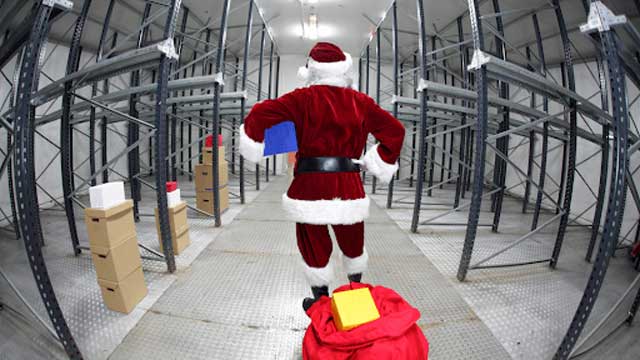Are You Ready For This Holiday Season?
Businesses are gearing up for the busy holiday season. This one could be a bumpy ride. They are cautioning that the mantra “order early” is especially important this year. There are several forces in play that will likely significantly impact the cost of products and the rate at which they can be delivered. A perfect storm is brewing that even Santa may not be able to weather.
Labor Shortages During the Holiday
The holiday season has typically meant a mass hiring of temporary workers. This year, it won’t be so easy.
Many companies are already experiencing a shortage of regular, full-time employees. The logistics industry has not been spared, and is now confronting a lack of truck drivers, package handlers, and other warehouse personnel.
There are numerous reasons for this. Baby boomers are retiring. Current birth rates are not at replacement levels, resulting in a shrinking pool of available workers. There is a mismatch between the skills that employers need with the availability of those skills. Many people that found themselves unemployed due to the COVID-19 pandemic are choosing not to return; surges in the delta variant are continuing to impact staffing. The elephant in the room right now is whether employer vaccination mandates will further hamper the American economy.
The Job Openings and Labor Turnover Summary (JOLTS) released from the U. S. Bureau of Labor Statistics in September reported a record 10.9M job openings in July 2021. The October report for August listed a slight decline to 10.4M job openings.
Logistics industry giant FedEx reports that worker shortages had a $450M impact last quarter due to widespread inefficiencies in its operations, causing rerouting, diversion of packages, and longer delivery times. These labor shortages are occurring despite an increase in hourly rates.
United Parcel Service (UPS) also reports a very tight labor market. They and FedEx are responsible for transporting a combined 14% of the United States gross domestic product (GDP).
These companies have plans in place to lure additional bodies for the holiday season. These plans include pay premiums, tuition reimbursement and almost immediate job offers after application. Will it be enough?
Supply Chain Disruptions During the Holiday
Supply chain issues erupted during the pandemic. Companies decreased capacity, fearing reductions in future demand. Factories were shuttered and ports closed in efforts to contain the virus. Quarantine and social distancing delayed transit times. Contrary to expectations, consumer demand did not decline. In fact, buying reached new levels, particularly online.
Holiday buying is ramping up, but kinks in the supply chain have retailers worried. These kinks are creating inventory shortages, forcing them to raise prices.
A vessel congestion update from the Western Overseas Corporation reports a record number of ships waiting to enter ports. Some estimates place the wait time for an available berth at up to three weeks. Some ports along the Gulf of Mexico have been closed due to the devastation from Hurricane Ida. Plans are underway for relief. Ports are expanding hours, including night and weekend.
Other links in the supply chain have been working to shore up efficiencies and increase capacity. Rail companies and warehouses are doing what they can to improve the situation. Currently, switching to air cargo is not an economical solution.
Trucking is the key to relieving congestion at ports, railways, and warehouses, but it has become the weakest link in the supply chain. Shortages in the number of drivers, as well as limits on the number of hours that they can safely work, are constraints that are difficult to overcome.
Improvements in processes, where possible, will help alleviate congestion along the supply chain providing there are enough bodies to complete the tasks. Will there be any relief before the holiday rush?
Manufacturing Issues During the Holiday
Manufacturing is struggling to meet high consumer demand. Their ability to bounce back after the global shutdown due to COVID-19 is proving to be difficult. Restarting their processes is being hindered by the same forces discussed above regarding labor shortages and supply chain disruptions.
In addition, manufacturers have been unable to get raw materials and key components needed for their end products. Increasing demand is partly to blame, but some of these shortages are being driven by pandemic lockdowns in Asia. Tariffs are another barrier. Factory fires, like the one at the semiconductor plant in Japan, are also contributing. Limits on China’s electricity usage due to climate change has forced them to curtail their production of magnesium, a mineral essential to the manufacture of electric-vehicle batteries.
One industry particularly hard hit by all of this is the auto industry. They not only rely on magnesium and semiconductors, but also plastics, resins, and steel, which are also in short supply. This is causing a steep decline in the number of new vehicles rolling off assembly lines. Some vehicles are finished, sitting in parking lots, waiting on a computer chip. The Wall Street Journal reports that the computer chip shortage is projected to cost the global auto industry a loss of 7.7M vehicles and $210B in revenue this year.
Other industries are also facing shortages. Building costs have skyrocketed due to the price of lumber. The food industry has experienced shortages. Even packaging materials, such as bottles, labels, and cardboard, have been in short supply.
Finding the material to produce a product is only half the battle. Once a manufacturer finishes a product it is difficult to get it into the supply chain. There is a shortage of shipping containers in circulation. Many containers are empty, stuck in the wrong places, and not turned over because other routes are more profitable. Costs for all modes of transportation have increased due to labor shortages, increased fuel costs, and longer transit times. Can these challenges be overcome in time to meet holiday demand?
Shortages in labor, lack of materials, and supply chain issues are so entwined that it is difficult to tease out cause and effect. Regardless, they are generating concerns for the upcoming holiday season. Awareness of these issues that may potentially impact your business is a good first step. The right fulfillment partner can help you mitigate problems and focus your efforts on the factors that you can control.
See if Aero Fulfillment Services is the right fit for you by taking this 1-minute survey.

